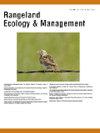Effects of Dormant Season and Contemporary Spring-Summer Grazing on Plant Community Composition in the Sagebrush Ecosystem
IF 2.4
3区 环境科学与生态学
Q2 ECOLOGY
引用次数: 0
Abstract
Livestock grazing is the primary land use across sagebrush ecosystems in the western US and its effects have been subject to extensive research and debate. Historical overgrazing, annual grass invasion and associated increase in fire frequency, conifer encroachment, climate change, and human modification have resulted in the loss or degradation of 86% of sagebrush ecosystems, leading to intensified interest in how remaining intact rangelands are managed. Unlike historical, continuous grazing, contemporary practices generally incorporate planned periods of rest and recovery from grazing during the growing season. Dormant season grazing is one such practice that shows promise for improving degraded rangelands and reducing wildfire risk. However, no studies have compared moderate intensity dormant season grazing to contemporary spring-summer grazing and grazing exclusion in sagebrush rangelands dominated by perennial bunchgrasses. We evaluated the effects of contemporary spring-summer grazing, dormant season grazing, and grazing exclusion on plant community characteristics in a Wyoming big sagebrush ecosystem. We expected the effects of dormant season grazing to be comparable to grazing exclusion. Deep-rooted perennial bunchgrass cover and density and shallow-rooted perennial bunchgrass cover in grazed areas did not differ from grazing exclusion (control) sites, and we found no support that grazing altered the deep-rooted perennial bunchgrass community through time. Dormant season grazing reduced native annual forb and sagebrush cover, but increased density of the shallow-rooted perennial bunchgrass. Our results suggest contemporary spring-summer or dormant season grazing are unlikely to lead to a decline in desirable perennial bunchgrasses.
休眠期和当代春夏放牧对山艾属植物群落组成的影响
放牧牲畜是美国西部荞属植物生态系统的主要土地利用方式,其影响一直受到广泛的研究和争论。历史上的过度放牧、每年的草入侵和相关的火灾频率增加、针叶树入侵、气候变化和人类改造导致了86%的山艾草生态系统的丧失或退化,导致人们对如何管理剩余的完整牧场的兴趣日益浓厚。与历史上的连续放牧不同,当代的做法通常包括在生长季节放牧后的计划休息和恢复时期。休眠期放牧就是这样一种做法,它有望改善退化的牧场,降低野火风险。然而,在以多年生束草为主的山艾草草地上,尚无研究将中度休眠期放牧与现代春夏放牧和放牧隔离进行比较。研究了当代春夏放牧、休眠期放牧和禁牧对怀俄明州大山艾草生态系统植物群落特征的影响。我们预计休眠期放牧的影响与不放牧相当。放牧区深根多年生丛草盖度、密度和浅根多年生丛草盖度与不放牧(对照)地无显著差异,放牧对深根多年生丛草群落的改变不存在时间上的支持。休眠期放牧减少了本地一年生草本和山艾草的盖度,但增加了多年生浅根束草的密度。我们的研究结果表明,当代春夏或休眠期放牧不太可能导致理想的多年生束草的减少。
本文章由计算机程序翻译,如有差异,请以英文原文为准。
求助全文
约1分钟内获得全文
求助全文
来源期刊

Rangeland Ecology & Management
农林科学-环境科学
CiteScore
4.60
自引率
13.00%
发文量
87
审稿时长
12-24 weeks
期刊介绍:
Rangeland Ecology & Management publishes all topics-including ecology, management, socioeconomic and policy-pertaining to global rangelands. The journal''s mission is to inform academics, ecosystem managers and policy makers of science-based information to promote sound rangeland stewardship. Author submissions are published in five manuscript categories: original research papers, high-profile forum topics, concept syntheses, as well as research and technical notes.
Rangelands represent approximately 50% of the Earth''s land area and provision multiple ecosystem services for large human populations. This expansive and diverse land area functions as coupled human-ecological systems. Knowledge of both social and biophysical system components and their interactions represent the foundation for informed rangeland stewardship. Rangeland Ecology & Management uniquely integrates information from multiple system components to address current and pending challenges confronting global rangelands.
 求助内容:
求助内容: 应助结果提醒方式:
应助结果提醒方式:


